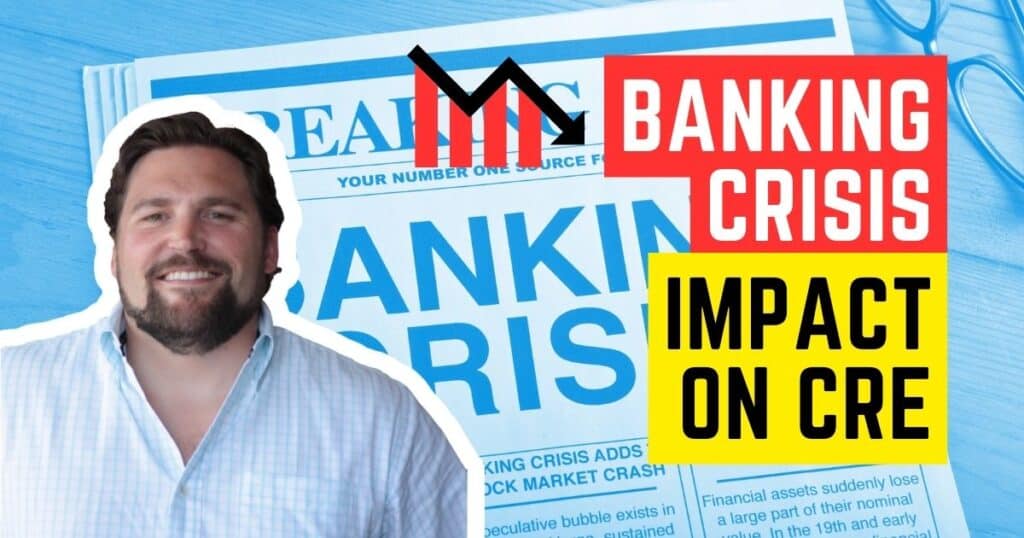
The Impact of the Banking Industry on Commercial and Residential Real Estate Markets – Real Estate Real Fast EP19
Episode Summary
How will the current state of the banking industry impact the commercial real estate market?
Silicon Valley Bank’s recent failure had a significant effect on the startup community that relied on the bank for funding, while the commercial real estate market is facing a crisis as local banks hold over $2.3 trillion in commercial real estate debt.
A potential collapse in the commercial real estate market could have significant negative effects on the economy, leading to job loss, market turmoil, and uncertainty that could trickle down to the residential markets.
However, the need to invest money somewhere could lead more investment dollars to funnel over into the housing sector as real estate is still considered a safe asset class to invest in.
Tune into this episode of Real Estate Real Fast to learn more about where things are headed in the commercial real estate market.
Episode Highlights
- The failure of Silicon Valley Bank and its impact on the startup community
- The current state of the banking industry and how it is affecting the commercial real estate market
- The looming crisis in the commercial real estate market, with many loans maturing and tightening lending options
- The potential effects of a collapse in the commercial real estate market on the economy and the residential market
- The interconnectedness of the commercial and residential real estate markets
- The impact of economic downturns on the real estate market
- Tips for navigating real estate investments during turbulent times
Episode Takeaways
[00:01:34] Silicon Valley Bank’s failure and its impact on startups
Silicon Valley Bank’s recent failure has had a widespread effect, particularly on the startup community that relied on the bank for funding. The bank’s risky venture debt loans and long-term treasury bonds, coupled with a liquidity crunch, led to its downfall. This caused fear and panic among customers, resulting in a run on the bank and ultimately its failure.
[00:03:04]-[00:03:26]
“Imagine you’re a startup and all your funds get locked up and you can’t make payroll and you have 50-100 employees that aren’t getting paid or you don’t know how they’re going to get paid. You’re only FDIC insured up to 250K. Some of these companies had millions upon millions of dollars with Silicon Valley Bank. So this affected a lot more people than just some rich guys from Silicon Valley.”
[00:08:05] Commercial real estate debt crisis may hit local banks
The commercial real estate market is facing a looming crisis as local banks hold over $2.3 trillion in commercial real estate debt. Additionally, 17% of US office stocks (commercial office building loans) are maturing this year. With tightening lending options, climbing interest rates, and falling occupancy rates, property values are decreasing, we might see a higher default rate. If the banks have to manage more foreclosures, the impact may ripple through the economy.
[00:11:45]-[00:12:29]
“If occupancy rates fall and the owner of that building is collecting less rent, the value of that building is coming down. And then you have rates that are climbing, in a lot of cases doubling or even tripling.
So those financing options from these local banks are either disappearing completely, they’re just off the table because right now, in the banking environment that we’re in, everything is tightening up, or the new terms on a new loan are just not tenable for that owner.
They either require too much additional cash to put down to meet the equity requirements, or the capitalization rate is too low or even negative and you can refinance and you’re still taking a loss. So it becomes very problematic.”
[00:14:12] Impact of small bank failures on real estate financing
The failure of small banks can affect not just the commercial real estate industry but the residential one as well. Small banks also create loan products for investors doing flips or buy-and-holds and issue loans for residential and multifamily properties. When the rate and banking environment changes, these products can become scarce, making options less readily available for seasoned investors or those with a proven track record of success.
[00:15:31]-[00:15:41]
“So when we see the rate environment change and we see the banking environment change, a lot of those products just start to go away, they start to tighten up.”
[00:17:15] The correlation between commercial and residential real estate markets
Commercial real estate and residential real estate markets are closely tied. In normal markets, when the commercial market is up, the residential market is also in high demand. However, the COVID-19 pandemic has caused some changes in the correlation between the two markets.
[00:18:12]-[00:18:35]
“COVID has changed things a little bit and there is still correlation there, but it just doesn’t follow the same way it would have in years past, because just geography has changed for businesses. People are working from home more than they were in the past. So the pool of employees that you can hire expands to the entire country rather than the local market that you’re in. So it’s not necessarily fundamentally tied to everybody having to live and be right near their office.”
[00:19:33] Potential effects of a collapse in commercial real estate market on the economy and real estate markets
A potential collapse in the commercial real estate market could have significant negative effects on the economy, leading to job loss, market turmoil, and uncertainty which could trickle down to the residential markets. However, the need to invest money somewhere could lead more investment dollars funneling over into the housing sector, as real estate is considered a safe asset class to invest in. While the commercial and residential real estate markets are currently experiencing opposing trends, it is important to understand the situation and react accordingly.
[00:21:23]-[00:22:18]
“I’m very nervous about the commercial real estate market. I think we’re going to have to see some kind of a backstop with the banks to give them flexibility to work with the owners of these buildings to give them viable financing options. Without that, you could largely start seeing that the highest percentage of commercial owners in a city are banks. If we get to the point where these loans mature, so 17% of loans mature this year, more in years to follow.
And if we don’t figure out a way to solve this problem and the banks start taking these properties back, these banks then have to carry these properties on their balance sheet.
They want to get them off as fast as possible. They don’t want to be in the commercial landlord business or even be in the property ownership business. So they’re selling their fire, selling at a loss that’s pulling values of other commercial real estate down simultaneously. That would obviously be the worst case scenario for the commercial real estate market.”
Related Posts
Selling a House Without a Realtor: Hidden Costs & Risks
When homeowners consider the risks of selling a house without a realtor, they often focus solely on potential commission savings. However, FSBO homes sold for a median of $380,000 in 2024, compared to $435,000 for…
Do You Need a Realtor to Sell a House?
The latest data from the National Association of Realtors shows that 90% of home sellers use agents, but this raises an important question: Do you need a realtor to sell a house? While the majority…
2025 Texas Real Estate Housing Report: Market Trends, Prices, and Forecasts
The Texas real estate landscape continues to evolve as we move through 2025, presenting both opportunities and challenges for buyers, sellers, and investors across the Lone Star State. This comprehensive 2025 Texas Real Estate Housing…




